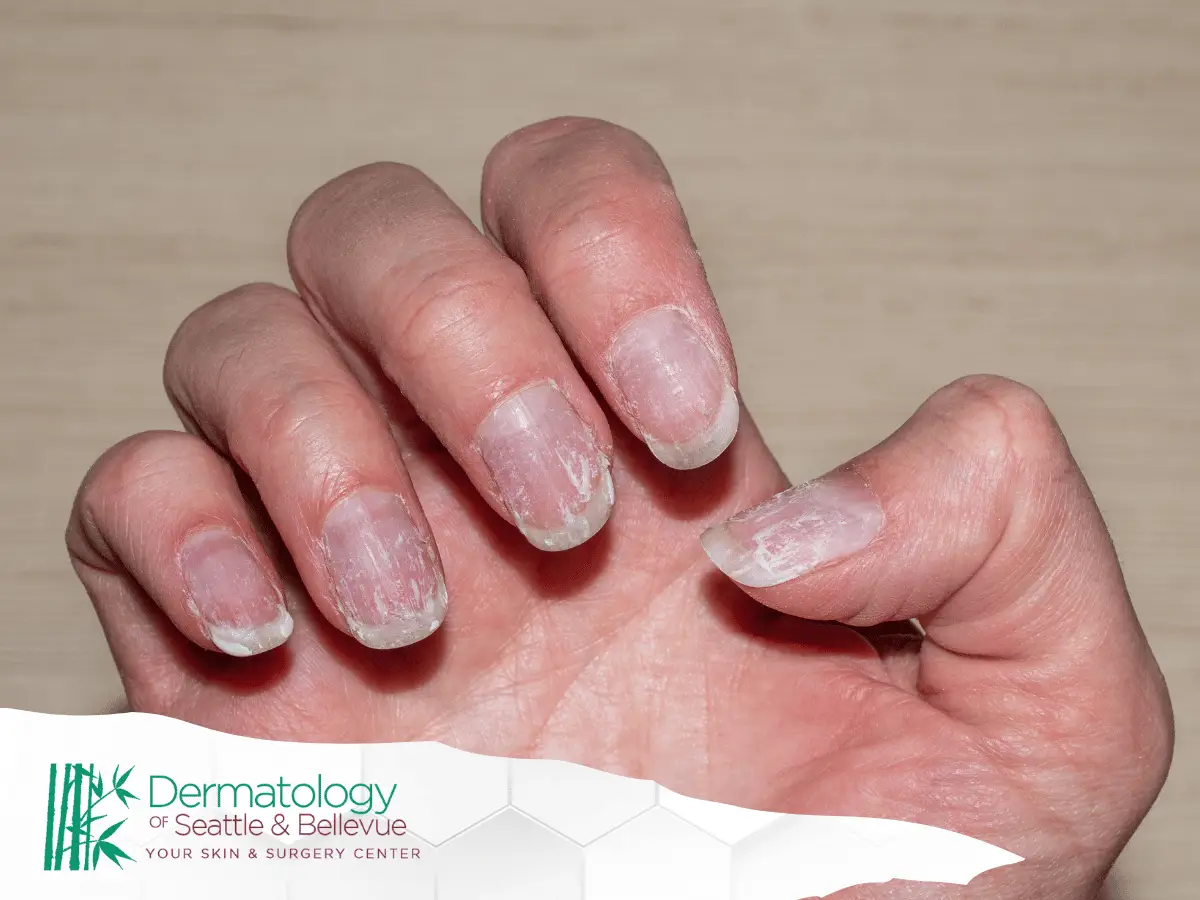When you think of melanoma, your skin probably comes to mind—but this dangerous form of cancer can also develop in your nails. Knowing how to spot nail melanoma: signs you should never ignore is crucial for early detection and effective treatment. One of the rarest and most overlooked forms of skin cancer, subungual melanoma, can go unnoticed for months due to its subtle appearance and location.
Quick Summary
- Nail melanoma (subungual melanoma) starts in the nail matrix under the nail and can be missed because it resembles bruises, fungal infections, or other common nail problems; it often affects the thumb or big toe.
- Key warning signs include a persistent brown/black/gray spot or a vertical dark band that widens, has uneven color or jagged edges, and may spread into the cuticle or surrounding skin.
- Other concerning changes include swelling/redness/tenderness around the nail without clear injury, unexplained thickening, new brittleness or crumbling in one nail, and bleeding under the nail that doesn’t fade like a typical bruise.
- Risk factors include age over 50, personal or family history of melanoma, and prior radiation exposure; it can occur in any skin tone and isn’t strongly linked to UV exposure.
- If symptoms persist or worsen, see a dermatologist; diagnosis typically requires a biopsy, and early detection improves treatment outcomes, which often involve surgical removal and sometimes additional therapy.
This blog breaks down what nail melanoma looks like, how it differs from common nail symptoms, and what to do if you spot something unusual.
Understanding Nail Melanoma
Nail melanoma—also called subungual melanoma—originates in the nail matrix, the tissue beneath the nail where new cells form. While it’s rare compared to other types of melanoma, it can be just as deadly if not diagnosed early. Because it often mimics minor issues like a bruise or dark spot, many people don’t realize there’s a problem until the disease has advanced.
Unlike traditional skin-based melanomas, subungual melanoma often appears as a discoloration or change in the nail, rather than a visible mole.
What is Nail Melanoma?
Subungual melanoma usually starts under the nail bed and can affect both fingernails and toenails—though the thumb and big toe are the most common sites. Unlike white spots, ridges on nails, or yellow nails caused by trauma or vitamin deficiency, this cancer tends to progress slowly but dangerously.
Key facts about nail melanoma:
- It typically appears as a vertical stripe or dark line running from the cuticle to the tip
- Can affect people of all skin tones but is more common in individuals with darker skin
- May occur without any known risk factors or sun exposure
- Can be mistaken for a fungal infection or brittle nail condition
Understanding these basics helps separate serious nail symptoms from cosmetic concerns.
Risk Factors for Nail Melanoma
Though anyone can develop subungual melanoma, certain risk factors increase the likelihood. These include a personal or family history of melanoma, previous radiation exposure, and being over the age of 50. People with darker skin tones may be more likely to develop this cancer on nail beds rather than sun-exposed skin, making awareness even more critical.
It’s also worth noting that unlike many other skin cancers, nail melanoma is not closely linked to UV exposure. This makes routine nail observation a vital part of your overall health monitoring, regardless of your sun habits.
Recognizing the Signs
Spotting nail melanoma early can literally save your life. Since the condition is often mistaken for benign issues, knowing the right signs and symptoms can help you take swift action. Changes may be subtle at first, but a dark line, discoloration, or swelling around a nail should never be ignored.
The next sections will highlight the most common warning signs, broken down by color, structure, and surrounding tissue changes.
Changes in Nail Color
A major red flag for subungual melanoma is an unexplained change in nail color—especially if it appears gradually. You might see a brown, black, or gray spot, or an entire band of discoloration stretching from cuticle to tip.
Color changes to be concerned about:
- A persistent dark spot or band that widens over time
- Pigment that spreads into the cuticle or surrounding skin
- A noticeable shift in color not related to injury or known cause
While many nail changes are harmless, these warning signs should always be discussed with a doctor.
Vertical Dark Bands on Nails
One of the hallmark indicators of subungual melanoma is a vertical stripe or dark line running the length of the nail. This band often starts thin and becomes wider over time, potentially extending into the cuticle or surrounding skin.
It’s important to distinguish these from natural ridges or pigment bands seen in some ethnic backgrounds. A suspicious line typically has:
- Uneven color—may be brown, black, or a mix of both
- Blurred or jagged edges
- Change in thickness or spread into nearby tissue
- No history of trauma or bruise that could explain it
If you’re unsure whether a stripe is concerning, always consult a doctor—especially if it’s on your thumb or big toe.
Inflammation and Swelling Around Nails
Swelling, redness, or tenderness near the nail could be a symptom of infection—but in the absence of an injury, these signs may point to something more serious. Subungual melanoma sometimes causes the skin near the nail bed to appear inflamed or raised.
When accompanied by a dark spot, discoloration, or new brittle texture, inflammation should never be brushed off. This is especially true if it persists for weeks or appears without a clear cause.
Examining Nail Texture
In addition to color and spot changes, shifts in the texture of your nails can also indicate underlying issues—including melanoma. A healthy nail is usually smooth, strong, and consistent in appearance. Any new deformities or surface irregularities may signal a need for closer inspection.
The following sections will explore how melanoma can affect nail thickness, durability, and structural integrity.
Changes in Nail Thickness
Unexplained thickening of a nail—especially in just one digit—can be a potential warning sign. While trauma and fungal infections can also cause thickness changes, subungual melanoma can alter the structure of the nail as it invades deeper layers like the nail matrix.
This may result in a distorted, raised, or uneven nail surface. Pay attention to whether this change appears without an obvious cause and if it worsens over time.
Brittle or Crumbly Nails
Brittle nails can develop from aging, vitamin deficiency, or external stressors like harsh products. But when a nail suddenly becomes dry, splits, or crumbles—especially in a single finger or toe—it may signal something more serious.
In rare cases, nail melanoma may weaken the keratin structure of the nail, leading to sudden fragility. If you’ve ruled out more common issues, brittle or crumbly nails paired with other symptoms should be evaluated by a professional.
Bleeding Under the Nail
A spontaneous bleed under the nail—without injury—is a strong red flag. Subungual melanoma can sometimes cause fragile blood vessels or ulcerations beneath the nail bed, leading to persistent discoloration that doesn’t behave like a typical bruise.
Unlike a standard injury, this type of bleeding may not move or fade as the nail grows, and it can cause visible damage to the cuticle or surrounding skin. Persistent or unexplained blood spots are never something to ignore.
Seeking Professional Help
If you notice any nail abnormalities that raise concerns—especially a vertical stripe, dark spot, swelling, or structural change—it’s essential to seek help from a dermatologist. Catching subungual melanoma early significantly improves the outcome of treatment and reduces the risk of spread to other areas of the body.
Even if it turns out to be something harmless, it’s better to ask questions than to overlook a potentially serious issue.
Consulting a Dermatologist
A dermatologist trained in nail health and skin cancer can evaluate unusual nail symptoms using specialized tools and techniques. Don’t hesitate to make an appointment if you notice:
- A dark line or spot that’s getting wider or darker
- Swelling or bumps near the nail with no clear cause
- Nail pain, tenderness, or bleeding without trauma
- Pigment spreading into the surrounding skin or cuticle
- Changes in nail thickness, shape, or color
These signs may seem subtle, but they’re exactly what dermatologists are trained to assess.
Importance of Early Detection
Early detection of nail melanoma is life-saving. Like other forms of melanoma, this cancer can metastasize quickly if left untreated. The earlier it’s caught, the more effective the treatment options—often with less invasive procedures and better long-term outcomes.
Don’t wait for pain or severe changes to take action. A small spot today could lead to serious health consequences tomorrow if ignored.
Nail Biopsy and Diagnosis
If a dermatologist suspects nail melanoma, the next step is usually a biopsy. This involves removing a small sample of tissue from the nail bed or nail matrix for examination under a microscope. While it may sound intimidating, the procedure is quick and typically done under local anesthesia.
A biopsy is the only definitive way to confirm whether a suspicious nail spot is benign or cancerous. In many cases, early diagnosis leads to far less invasive treatment.
Taking Action
Once subungual melanoma is confirmed, prompt treatment is critical. Unlike other skin conditions, this form of cancer doesn’t go away on its own—and waiting can allow it to spread to other parts of the body. Thankfully, when detected early, nail melanoma is highly treatable with a range of surgical and medical options.
In this section, we’ll cover what you can expect after a diagnosis, how to prevent recurrence, and how to stay alert for new signs.
Treatment Options
Treatment for nail melanoma typically involves surgical removal of the cancerous tissue. This can include excising part or all of the affected nail, and in some advanced cases, even a portion of the bone or fingertip. However, this level of intervention is rare when the disease is caught early.
Some patients may also undergo additional therapy, such as radiation or targeted drugs, depending on the stage of cancer. Long-term outcomes are generally excellent with timely intervention.
Preventive Measures
While not all cases of nail melanoma are preventable, certain steps can lower your risk and improve your overall nail and skin health. Routine checks, protecting your hands and feet, and avoiding nail trauma are all smart habits to adopt.
A few preventive measures include:
- Avoiding unnecessary radiation or repeated nail injuries
- Keeping nails clean and trimmed to prevent infection
- Wearing gloves during harsh chemical or cleaning tasks
- Steering clear of aggressive manicures or pedicures that damage the cuticle
- Seeking prompt care for any strange spots, lines, or persistent symptoms
Prevention starts with awareness and care—both of which are easy to maintain once you know what to look for.
Monitoring Changes in Nails
Regular monitoring is your best defense against late-stage nail melanoma. Use your monthly skin checks to examine each nail closely, and take photos if something looks unusual. Watch for new spots, growth of existing lines, or changes in nail texture.
Be especially cautious with changes on your thumb, big toe, or cuticle areas, as subungual melanoma most often starts there. Regular self-examinations can help in early detection, making it crucial to monitor any unusual changes in these areas. Engaging in melanoma awareness in Seattle can also provide valuable resources and support for individuals concerned about skin health. Promptly consulting with a healthcare professional if you notice any suspicious signs can greatly improve outcomes.
Educating Others
Raising awareness about nail melanoma can help save lives. Since it’s a lesser-known form of skin cancer, many people ignore the signs or dismiss them as cosmetic issues. By sharing what you’ve learned, you can help others understand that not all melanomas look like a mole on the skin.
Spreading Awareness
Talk to family and friends about nail health and melanoma risks. If someone mentions a strange stripe, discoloration, or spot, encourage them to get it checked out.
Posting about your experience or knowledge on social media, or sharing educational resources, is a simple but powerful way to keep others informed.
Encouraging Regular Skin Checks
Most people know to watch for moles, but few check under their nails. Help others form good habits by recommending full-body skin exams that include the feet, hands, and nail beds. These checks are fast, free, and can lead to lifesaving early detection.
Support Networks and Resources
Being diagnosed with nail melanoma can be overwhelming. Fortunately, many dermatology clinics, cancer organizations, and online groups provide emotional support, clinical guidance, and answers to difficult questions.
- Reach out to your local dermatology practice for screening or referrals
- Check national cancer organization websites for the latest science and treatment options
- Join forums or support groups to share questions, stories, and tips for managing health concerns





